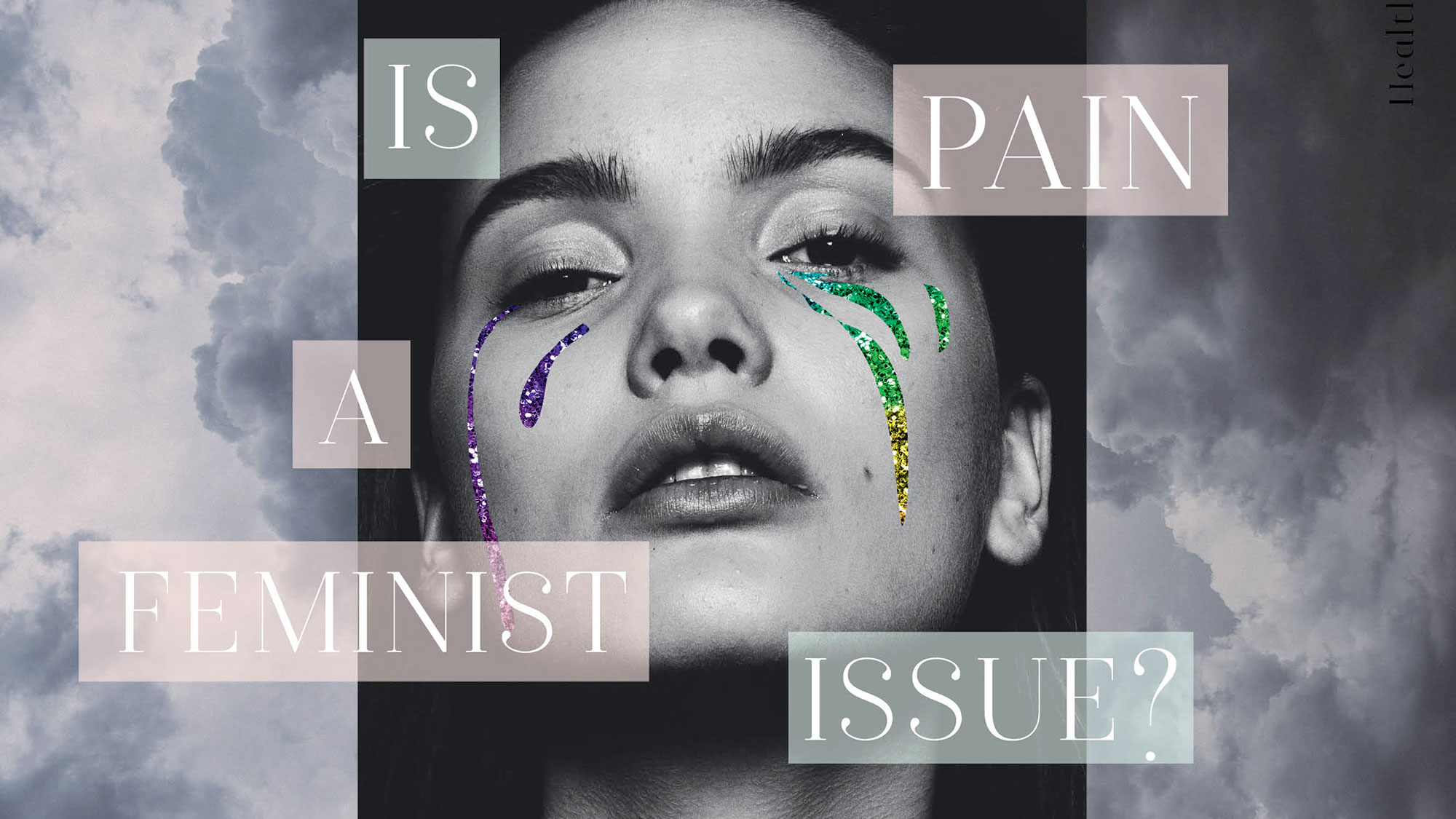Is pain a feminist issue?
Research shows female and male pain are treated differently, with doctors routinely dismissing women’s pain as less serious. Rosie Mullender examines a gender bias that may be costing lives

Research shows female and male pain are treated differently, with doctors routinely dismissing women’s pain as less serious. Rosie Mullender examines a gender bias that may be costing lives
Becca Fowles was rocking back and forth, sobbing with pain, and knew something was seriously wrong. Since her periods had started at 14, they’d been heavy and intensely painful, lasting up to nine days. Her GP had told her they were normal and put her on the pill, which regulated the symptoms. But when she took a break, the pain returned with a vengeance. ‘I was 26, and had forgotten how painful my periods could be,’ says Fowles, 34, a marketing manager. ‘I started wondering, “Is this in my head? Am I making this bigger than it is?’’’ It was another year before a doctor in Japan, where she was living, diagnosed her with endometriosis – an often agonising disorder in which cells like the ones in the uterus are found elsewhere in the body.
In 2015, Fowles returned to the UK and had her first operation, which revealed scar tissue on her bladder and portions of her bowel stuck to her pelvis. After surgery, her pain worsened, but again, she was dismissed. ‘I was told, “It’ll heal, it’ll be fine,”’ she says. ‘No one thought something might have gone wrong, or that the pain could be abnormal.’ Further surgery revealed that there were patches of endometriosis growing inside her bladder. ‘I’ve had more operations since then, including a pacemaker fitted to help me urinate,’ says Fowles. ‘I still suffer from chronic pain in my hip, and there are plans for me to be given steroid injections. I wonder if my pain was taken seriously years ago, doctors could have treated me before things got so severe.’
Fowles is far from alone. On average, it takes a shocking seven and a half years for endometriosis to be diagnosed. But, as well as being a difficult disease to detect, studies show that globally women in pain are treated differently to men – a ‘gender pain gap’ that puts them at a deadly disadvantage. Worryingly, this bias, responsible for so much suffering for women with gynaecological pain, extends to other types of pain, too.
Studies have shown that women are less likely to receive painkillers, are more often misdiagnosed than men, and even female children’s pain is considered less serious than boys. In a US study*, adults were asked to assess a five-year-old’s reaction to pain. When they were told the child was called ‘Samuel’, they assumed it was in more pain than when they were told it was called ‘Samantha’. This helps to explain why, from their early years, women are assumed to suffer less pain than men and conditioned to put up with it.
‘In general, women are thought to make a lot of fuss about something that’s not serious,’ says Dr Amanda Williams, a clinical psychologist at University College London. ‘There’s a cultural tradition that regards women as unreliable witnesses. In this environment, pain can become normalised. Women know periods and sex can be painful. It sets a precedent, and an acceptance that for some, pain is unavoidable.’
This difference is more profound for woman of colour. People from ethnic minorities admitted to hospital in the UK report much poorer experiences than white patients. The risk of dying in childbirth is also seven times higher for black women than those who are white and British born. Candice Brathwaite believes she was a victim of racial bias when she gave birth to her first child. The influencer and co-founder of Make Motherhood Diverse developed sepsis following a caesarean in 2013, and almost died after she was told her pain was normal and sent home. ‘I felt the white women were listened to more – the midwives would be reassuring to them, but sigh when I complained about my pain,’ says Brathwaite, 31. ‘And when I was wheeled into theatre, the surgeon said, “Can we hurry this one up? I was supposed to be home an hour ago.” I can’t help putting his attitude and developing sepsis together. It felt like there was a racial bias there.’
Marie Claire Newsletter
Celebrity news, beauty, fashion advice, and fascinating features, delivered straight to your inbox!
‘A lot of medicine is a case of deciding if pain is “serious” or “not serious”,’ says Dr Adam Kay, author of This Is Going To Hurt. ‘Obviously, anyone who has been dismissed as “not serious” and ended up in need of medical help is absolutely right to have grievances. Sadly, I suspect women suffer from this more. Monthly abdominal pain being a normal feature of their lives gives doctors an easy way to brush things off,’ he adds. ‘But it’s also because they sometimes subconsciously (and wrongly) think women have a lower pain threshold, and take pain more seriously in men.’ It’s no wonder we all cheered at Kristin Scott Thomas’s speech in Fleabag: ‘Women are born with pain built in… We carry it within ourselves throughout our lives. Men don’t.’
‘Women’s pain is often put down to hysteria’
Studies have also found that medical professionals have less desire to help overweight people, and less patience when they do. Author and mental-health activist Natasha Devon MBE nearly died when her pain was overlooked – partly, she believes, because she was a size 20. ‘I woke up unable to move, with shooting pains in my stomach and shoulder,’ the 38-year-old explains. ‘I called a friend, who dialled 999, but after asking if I was pregnant they decided my case wasn’t urgent. It took 90 minutes for an ambulance to arrive.’
In hospital, Devon was asked to rate her pain from one to ten. ‘I said nine and was sent to the waiting room. When I eventually saw a doctor, he said, “You’re quite a big girl. Do you eat a lot of spicy food?” He diagnosed indigestion, offered me Gaviscon, and said come back in 24 hours if I didn’t feel better. If I’d followed his advice, I’d have died.’
Realising Natasha’s pain wasn’t normal, her friend insisted on a second opinion. Another doctor agreed she should be kept under observation, and also gave the option of exploratory surgery. The procedure should have taken half an hour. Instead, she woke up after five hours with a 30cm scar from her pelvis to her chest. Surgeons had found 1.5 litres of internal bleeding from a ruptured spleen. ‘This is usually caused by something like a car accident, and there was a million to one chance of it happening by itself,’ says Devon. ‘But if my friend hadn’t been vocal about my pain, the outcome could have been very different. People have this idea that men are more stoic, so if they say they’re in pain, it must be severe. With women, it’s felt a degree of exaggeration has been applied. Now, I know you have to be prepared to fight your corner.’
One factor widening the gender pain gap is that male bodies have been the focus of medical research and drug testing. But huge pressures on staff also mean that mistakes are inevitable – a 2018 survey of NHS staff by the British Medical Association revealed that most are worried about making potentially life-threatening mistakes due to a lack of funding and staff shortages. In some cases, those mistakes are disproportionately hitting women: a third of people in England and Wales are given the wrong diagnosis after a heart attack, with women at a 50 per cent greater risk of being misdiagnosed than men.
Things are gradually improving though. The National Institutes of Health in the US issued fresh guidelines in 2017 on the inclusion of women in clinical research, which will impact global understanding of how women’s bodies respond to pain and medication. Thanks in part to female voices, medical professionals are also becoming more aware of the gap. ‘I always taught doctors to err on the side of caution and compassion,’ says Dr Kay.
Fowles, who writes about living with endometriosis at livingwithflare.online, suggests we stay vigilant. ‘Our pain is often put down to hysteria,’ she says. ‘But if you feel something is wrong, keep pushing.’
If you’re in pain, find advice and support at painuk.org
When to take pain seriously
Dr Claire Rushton, vice chairperson of the Family Doctor Association (family-doctor.org.uk), advises when to seek help, no matter what your level of pain
Low-level: If you’re suffering from a new pain you can’t explain – and that lasts for three or four days – you should get it checked out, especially if it doesn’t respond to painkillers. If your pain is associated with other symptoms, too – for example, pelvic pain with discharge or weight loss, or leg pain with swelling – see your GP immediately.
Chronic: If this isn’t being controlled by your current medication and keeps escalating, you might need an updated treatment plan.
Severe: This usually needs to be treated immediately. A sudden, very bad headache may be a sign of a bleed on the brain, and if you’re experiencing pain that’s keeping you up at night, see your GP or call 111 for out-of-hours advice.
*Source: The Journal of Pediatric Psychology
The leading destination for fashion, beauty, shopping and finger-on-the-pulse views on the latest issues. Marie Claire's travel content helps you delight in discovering new destinations around the globe, offering a unique – and sometimes unchartered – travel experience. From new hotel openings to the destinations tipped to take over our travel calendars, this iconic name has it covered.
-
 Jonathan Anderson is going to Dior Men
Jonathan Anderson is going to Dior MenHis debut collection will be this June
By Mischa Anouk Smith
-
 I'm a 2025 bride and these are the best affordable wedding dresses I've found
I'm a 2025 bride and these are the best affordable wedding dresses I've foundLess than £1,000 but still the height of chic
By Sofia Piza
-
 Hands down, these are the best wedding foundations for each skin type
Hands down, these are the best wedding foundations for each skin typeThat bridal glow, bottled
By Denise Primbet